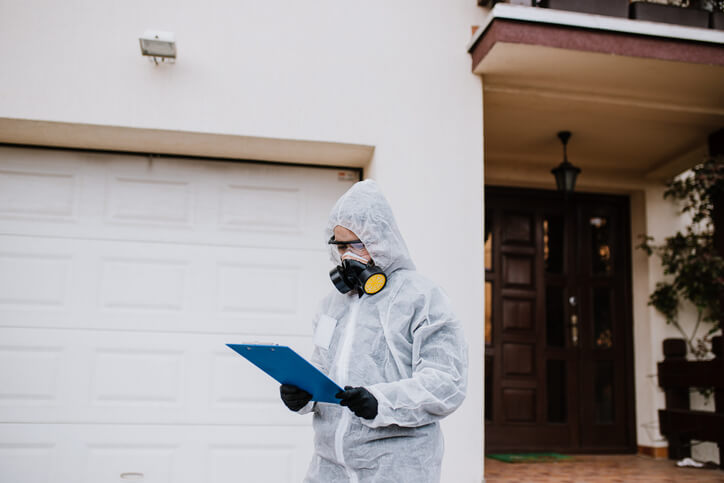
According to a recent report by CBC Calgary, Alberta Fish and Wildlife has created a list of 60 animals, including pigeons, bats, sparrows, and white-tailed jackrabbits, identified as pests due to their populations. If an animal is classified as a pest, no license is required to remove it from a property. However, it is recommended that people contact a Fish and Wildlife officer for advice on the legal methods for removal. You can find the entire list of Alberta pests here.
Most Common Pests From the Alberta Pest List
The Alberta pest list includes a variety of animals identified as pests due to their impact on the environment and human activities. Here are some of the most common pests on the list:
- Pigeons. Often found in urban areas, pigeons can cause significant damage to buildings and structures with their droppings. They are also known to carry diseases that can affect humans.
- Bats. While bats play a crucial role in controlling insect populations, they can become pests when they roost in buildings. Their droppings, known as guano, can create health hazards and unpleasant odors.
- Sparrows. These small birds can be found in both urban and rural areas. They often nest in buildings and other structures, causing damage and creating messes with their droppings.
- White-tailed jackrabbits. These large hares can cause extensive damage to gardens and crops. They are particularly troublesome in agricultural areas where they feed on various plants.
- Rats and mice. Common in both urban and rural areas, these rodents can cause significant damage by chewing through wires, insulation, and other materials. They also pose a health risk by transmitting life-threatening diseases.
- Skunks. Known for their distinctive odor, skunks can become pests when they dig up lawns and gardens in search of food. They can also transmit rabies and other dangerous diseases.
- Raccoons. These nocturnal animals can cause extensive damage when they raid garbage cans, gardens, and homes. They are also recognized for carrying diseases like rabies.
- Squirrels. Often found in urban and suburban areas, squirrels can damage homes and other structures by chewing through wood, wires, and insulation. They also invade bird feeders and gardens.
- Magpies. These birds are known for their loud calls and scavenging behavior. They can become pests when they raid gardens, garbage cans, and pet food dishes.
- Coyotes. While they generally avoid human contact, coyotes can become pests when they prey on livestock, pets, and wildlife in residential areas.
To control these and other pests on the pest list in Alberta, it’s best to call in professionals who use safe, proven, and reliable control methods.
Pest Control From Alberta Pest List
An important part of our job as a pest control company here in Calgary is completing a thorough inspection of a residential or commercial site and determining a safe treatment for removing the pest in question without causing harm to the environment, children, pets, families, and all non-target pests. People are usually surprised to find that particularly with tree spraying, some insects that appear as pests are benefiting rather than harming the trees.
Pest Control Methods From the Alberta Pest List
Pest control methods recommended by One Man & A Ladybug involve several techniques tailored to specific pests. For pigeons, exclusion methods such as bird netting, spikes, or electric tracks can prevent roosting on buildings, while habitat modification like securing garbage and removing bird feeders reduces food sources. Trapping and relocating pigeons using live traps is also an option.
Bats can be controlled by installing one-way doors or exclusion devices that allow them to exit but not re-enter buildings. Sealing entry points and removing potential roosting sites like old buildings and dead trees are effective strategies.
To manage sparrows, exclusion techniques like bird netting, screens, and barriers are useful in preventing nesting in buildings. Eliminating food sources and nesting sites around properties and using traps to capture and remove sparrows are also recommended.
For white-tailed jackrabbits, installing rabbit-proof fencing around gardens and crops is effective. Applying commercial rabbit repellents to plants and removing brush piles and other cover where jackrabbits may hide can also help.
Rats and mice can be managed by sealing entry points in buildings to prevent their entry. Trapping methods such as snap traps, glue boards, or live traps are effective, as is placing rodent baits in tamper-resistant bait stations.
Skunks can be controlled by installing barriers to prevent burrowing under structures. Using live traps to capture and relocate skunks, and removing food sources such as pet food and garbage, are recommended.
Raccoon control involves securing trash cans, closing off entry points to attics and basements, and using chimney caps. Live traps can be used to capture and relocate raccoons while removing food sources and nesting sites is also effective.
Squirrels can be managed by sealing entry points in buildings and covering chewable surfaces with metal flashing. Trapping and relocating squirrels using live traps and trimming tree branches that provide access to buildings are useful methods.
For magpies, exclusion methods like netting and barriers can keep them away from gardens and crops. Removing food sources and nesting sites, and using traps to capture and remove magpies, are recommended.
Coyotes can be deterred by using fencing to protect livestock and pets, removing food attractants such as garbage and pet food, and using deterrents like lights, noise makers, and guard animals.
It is crucial to follow local regulations and guidelines when performing any pest control services, so it is highly recommended to call in the professionals.
To learn more about eco-friendly pest control services from One Man and a Ladybug, click here or call a manager at (403) 262-1666.
